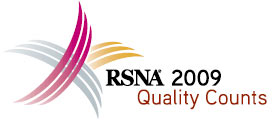Cloud in the Windy City
- 16 December 2009
 Neil Versel visits the Radiological Society of North America conference in Chicago and finds cloud computing and mobile applications are the big IT themes of the event.
Neil Versel visits the Radiological Society of North America conference in Chicago and finds cloud computing and mobile applications are the big IT themes of the event.
Much of the healthcare IT industry is moving toward the software-as-a-service model, so it was only a matter of time before cloud computing gained a foothold in medical imaging – even allowing for the high bandwidth and storage requirements of digital diagnostics.
And cloud computing may be just the thing to pull together imaging and clinical records data and facilitate widespread health information exchange.
“It’s inherently scaleable and very cost-effective,” Nancy Koenig, president of Merge Fusion, the imaging division of US-based software company Merge Healthcare, said at the recent Radiological Society of North America conference and exhibition in Chicago. “It’s applicable to those not able or willing to invest in an IT staff.”
Going mobile
Drawing 60,000 people each year, RSNA is billed as the largest medical meeting in the world. But it took mere minutes strolling the massive McCormick Place convention centre to realise that the 2009 edition was all about mobility – mobility of technology and mobility of data.
In fact, it took just a glance at the schedule to figure that out. All but one of the RSNA-sanctioned press conferences held at the event were more about life sciences than information technology. The one related to IT suggested that the screen resolution of smartphones – particularly Apple’s iPhone – has gotten so good that handsets are now suitable for making quick, preliminary diagnoses of acute appendicitis.
“The goal is to improve the speed and accuracy of medical diagnoses, as well as to improve communications among different consulting physicians,” said Dr Asim Choudhri, a neuroradiology fellow from Johns Hopkins University in Baltimore. “This new technology can expedite diagnosis and, therefore, treatment.”
In 125 readings of CT scans on iPhones for a study, five junior doctors made a total of just one error, Choudrhi reported. In every other case, the junior doctors agreed that 15 of the 25 patients whose records were reviewed had acute appendicitis and ten had a less urgent issue.
It took one to five minutes to download an 80-image CT scan, depending on the speed of the Internet connection, using a standard iPhone with OsiriX, a commercially available software application that permits transmission of medical imaging through iTunes.
That’s not particularly fast by hospital standards, but it creates teleradiology via health information exchange, suggested Dr Elliot Menschik, founder of Philadelphia-based health information exchange company HxTechnologies, now a subsidiary of care management software developer MEDecision.
As long as the transmission is fast enough to retrieve a small set of necessary images, it could avert a costly and time-consuming patient transfer between GP practice, imaging centre and hospital, for example.
“The patient doesn’t need to be transferred anymore in many cases,” Menschik said. “When the patient does need to be transferred, data is sent electronically and there’s a portal available for the referring physician [to view images or read a specialist’s report].
“You want to make [data transfer] as simple as pressing a button to burn a CD-ROM,” Menschik added. The cloud facilitates this.
Cloud bursts
Candelis, a Southern California health IT firm, debuted its own cloud service at RSNA for image management and workflow improvement.
“The evolution of cloud computing presents a unique opportunity to re-architect healthcare IT in a manner that better supports physicians, imaging centres and hospitals in their efforts both to enhance patient care and control costs,” Candelis chief technology officer Steven Higgins said in a company release.
Another vendor, DR Systems, launched a cloud-based network called eMIX (Electronic Medical Information Exchange) last month. At RSNA, it was using this system to link images and reports from picture archiving and communication systems (PACS) and radiology information systems (RIS). There were others who combined imaging and electronic health records (EHRs).
“Up to this point, it’s been on the imaging centre of the hospital to ship images out,” Allscripts regional sales representative, Jonathan Engel said about the image-enabling of EHRs. No longer do GPs need to have a different PACS viewer for each hospital or imaging centre they refer patients to.
“What we want to do is present, in the context of the EHR, a complete patient record,” added Atul Agarwal, Canada-based director of IT solutions for Merge OEM, the Merge division that sells software to EHR vendors, device manufacturers and systems integrators.
And just for good measure, Merge introduced an iPhone app of its own; eFilm for iPhone provides remote, mobile access to the Merge eFilm Workstation RIS.




